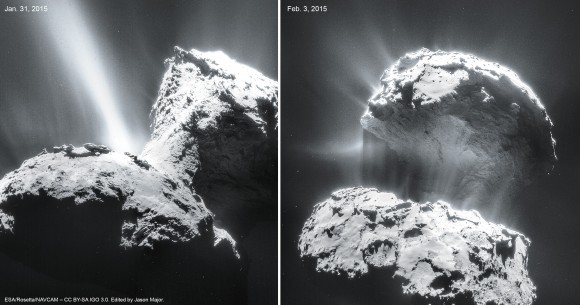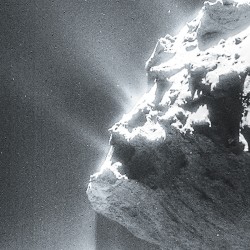Rosetta’s Comet Really “Blows Up” in Latest Images

Jet
activity on Comet 67P/C-G imaged on Jan. 31 and Feb. 3, 2015. Credits:
ESA/Rosetta/NAVCAM – CC BY-SA IGO 3.0. Edit by Jason Major.
The images above were captured by Rosetta’s NavCam on Jan. 31 and Feb. 3 from a distance of about 28 km (17 miles). Each is a mosaic of four separate NavCam acquisitions and they have been adjusted and tinted in Photoshop by yours truly to further enhance the jets’ visibility. (You can view the original image mosaics and source frames here and here.)
These dramatic views are just a hint at what’s in store; 67P’s activity will only be increasing in the coming weeks and months and, this weekend, Rosetta will be swooping down for an extreme close pass over its surface!
This Saturday, Feb. 14, Rosetta will be performing a very close pass of the comet’s nucleus, soaring over the Imhotep region at an altitude of only 6 km (3.7 miles) at 12:41 UTC. This will allow the spacecraft to closely image the comet’s surface, as well as investigate the behavior of its jets and how they interact with its developing coma.
“The upcoming close flyby will allow unique scientific observations, providing us with high-resolution measurements of the surface over a range of wavelengths and giving us the opportunity to sample – taste or sniff – the very innermost parts of the comet’s atmosphere,” said Rosetta project scientist Matt Taylor.
Read more about Rosetta’s Valentine’s Day close pass here and watch an animation of how it will be executed below.
Source: ESA

No comments:
Post a Comment